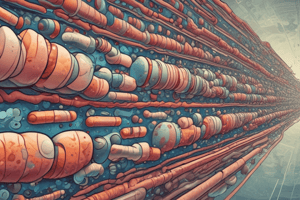Podcast
Questions and Answers
What is the mechanism of action of aminoglycosides?
What is the mechanism of action of aminoglycosides?
- Stimulates protein synthesis in bacteria
- Prevents protein synthesis in bacteria (correct)
- Inhibits cell wall synthesis in bacteria
- Prevents DNA replication in bacteria
Which family of bacteria are aminoglycosides commonly used for infections?
Which family of bacteria are aminoglycosides commonly used for infections?
- Anaerobic bacteria
- Gram-positive bacteria
- Enterobacteriaceae family (correct)
- Mycobacteria
What adverse effect should a nurse monitor for when a patient is on aminoglycosides?
What adverse effect should a nurse monitor for when a patient is on aminoglycosides?
- Neurotoxicity
- Nephrotoxicity (correct)
- Hepatotoxicity
- Cardiotoxicity
Why should patients on aminoglycosides be advised to take the full course of medication?
Why should patients on aminoglycosides be advised to take the full course of medication?
When should peak levels of aminoglycosides be monitored in a patient receiving the medication?
When should peak levels of aminoglycosides be monitored in a patient receiving the medication?
Study Notes
Aminoglycoside Action and Mechanism
- Prevent protein synthesis in bacteria, ultimately leading to cell death (bacteriocidal)
- Effective against gram-negative infections, including Pseudomonas and Enterobacteriaceae family, as well as bacterial endocarditis
Medications and Examples
- Amikacin, Gentamicin, Tobramycin, Kanamycin, Neomycin, Streptomycin, and Tobramycin are examples of aminoglycoside medications
Adverse Effects
- Nephrotoxicity: monitor renal function, watch for decreased urine output, fluid retention, and changes in creatinine clearance
- Ototoxicity: perform baseline audiogram and monitor for tinnitus, hearing loss, vertigo, and feelings of fullness in the ear
- Super-infections: risk of C. difficile (C-diff), pseudomembranous colitis (diarrhea), and fungal infections (candidiasis)
Nursing Considerations
- Close drug monitoring is essential, with peak levels (highest levels of medication) occurring 15-30 minutes after IV administration, 30 minutes to 1 hour after IM administration, and 1 hour after oral administration
- Trough levels ( lowest levels of medication) occur 30 minutes before next administration
- Emphasize the importance of patients completing the full course of medication
Studying That Suits You
Use AI to generate personalized quizzes and flashcards to suit your learning preferences.
Description
Test your knowledge on the mechanism of action of aminoglycoside antibiotics and their associated adverse effects such as nephrotoxicity and ototoxicity. Learn about the medications and bacterial infections commonly treated with aminoglycosides.




